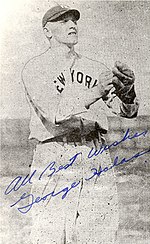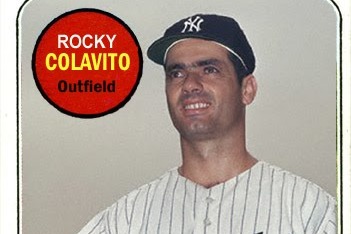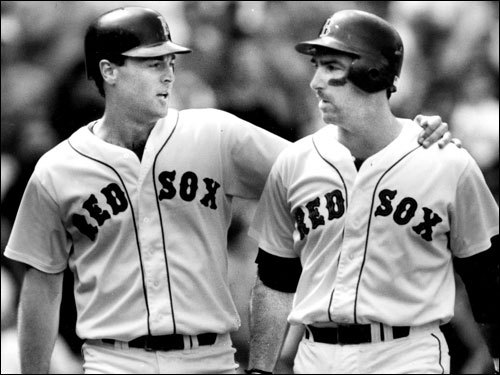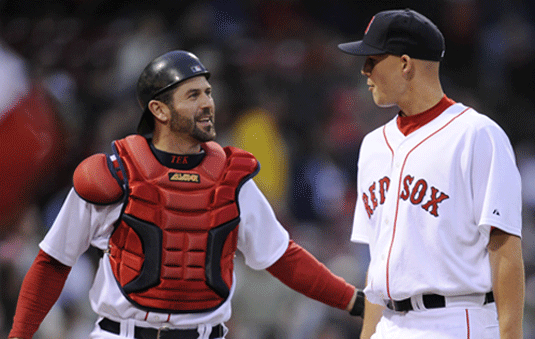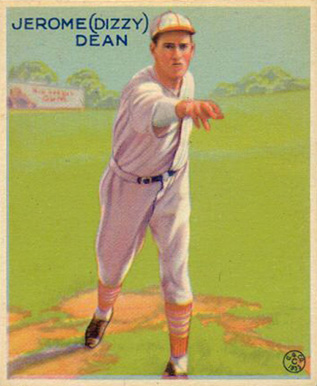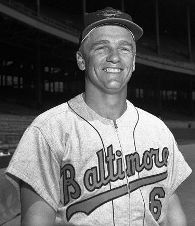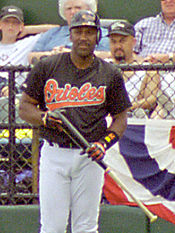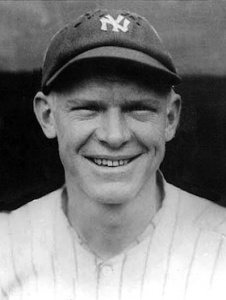Rube Oldring
When Connie Mack built his first dynasty, reaching the World Series in 1910, 1911, 1913 and 1914, the $100,000 infield is usually the first mentioned aspect of the dynasty. If it is not the infield then it may be the pitching of Chief Bender, Andy Coakley, Jack Coombs and Eddie Plank. Often overlooked is outfielder Rube Oldring. Not a Hall of Fame player, Oldring patroled the outfield for 12 years for Mack's white elephants. It is clear to say that Oldring played a pivotal role in the success of the A's. But before he played for Philadelphia he started with the New York Highlanders in 1905. In October of that year the A's selected Oldring as part of the Rule 5 draft and Mack cheaply added an important cog of the machine. As Mack's finances took a dip following the 1915 and 1916 seasons his powerful group was slowly dismantled. Oldring was released in July of 1916 and quickly signed by the New York Yankees where he finished the season.
Ira Thomas
Just like Rube Oldring, Ira Thomas was an under rated part of Connie Mack's dynasty. As the A's were dominating the American League, Thomas was behind the plate controlling the pitchers. Thomas played 7 years for Mack but before he became an Athletic he started with the Yankees. In 1906 and 1907 he was the backup Catcher to Red Kleinow. He was sold to the Tigers for the 1908 season where he backed up Boss Schmidt. He was then sold to the A's where he made his name as one of the best Catcher's in the league.
Joe Gedeon
Joe Gedeon had a relatively short career. He played only 7 years in the major leagues, his final three with the St. Louis Browns. He was an average player, his final season being his best. What he is remembered for most is the reason that 1920 was his final season. It seems that the year before, say around October, Gedeon was given some "advice". He was told by a good friend, Hal Chase, that it would be wise to bet against the Chicago White Sox in the World Series of 1919. He was given some specific details why he should bet that way and as a result he made some extra money. When Charles Comiskey offered a reward for any information regarding the rumors of a fix, Gedeon stepped forward hoping to get the reward. His reward was that he was banned from the game the same as Chase and the Black Sox. Before he became the Browns' starting second baseman Gedeon played the 1916 and 1917 seasons with the Yankees. Gedeon was the starter for New York during 1916 but was replaced by Fritz Maisel for the 1917 season. He was traded to the Browns in 1917 along with Nick Cullop, Maisel, Les Nunamaker and Urban Shocker in exchange for an older Eddie Plank and Catcher Del Pratt. The key man in the deal was Urban Shocker who the Yankees would regret giving up. Eventually they would get him back in time to be a part of the first Yankee dynasty.
George Halas
George Halas was born and raised in Chicago. He came to be identified with that city as much as Mayor Daley or Michael Jordan. Before he became famous in Chi-Town he played 12 games for the Yankees in the 1919 season. The Yankees were starting to field a competitive team in 1919, they would actually be in the pennant race the next year. During his 12 games Halas would go 2-22 (.091) at the plate with 8 strikeouts. After his failed season with the Yankees he went back home to Chicago where he played and coached the Decatur Staleys in the NFL. Two years later they would change their name to the Chicago Bears. Halas would coach and own the team and become known as "Papa Bear". Halas passed away in 1983 but his initials GSH were worn for several years on the sleeves of the Bears uniforms.
Dixie Walker
Dixie Walker is best remembered as a Brooklyn Dodger, for many reasons. Walker was the fan favorite in Brooklyn (he was known in Brooklyn as "the people's cherce") and played a key part in the Dodgers 1941 and 1947 World Series teams. He is also known as the man who started the petition to keep Jackie Robinson off the Dodgers' roster. Before he became the fan favorite in Brooklyn he played in the Bronx. Walker played 2 games for the Yanks in 1931 but became a regular in 1933, Babe Ruth's final year in pinstripes. As Babe Ruth and Earl Combs started to age the Yankees needed new blood and they found it in the deep south with new outfielders Walker and Ben Chapman. The two outfielders were close friends and roommates during Walker's 5 years in New York. When the Yankees signed DiMaggio, Walker became expendable. He would eventually wind up with the Dodgers. His time in New York at the end of Ruth's time there and in Brooklyn at the beginning of Robinson's made him the only player to have played with both Hall of Famers.
Paul Waner
Paul Waner had a Hall of Fame career spent mostly with the Pirates. In Pittsburgh he helped the Pirates reach the World Series in 1927 only to be swept by the Yankees team that some consider to be the greatest team of all time. As Waner aged, his talents started to decline. As Waner tried desperately to hold on to his career, teams were looking for anyone to fill out their rosters while the stars were overseas fighting World War II. Waner started the 1944 season with the Dodgers but was released in September. Fighting to keep their run of pennants going, the Yankees took a chance on Waner and signed him. He played a total of 9 games for the 1944 Yankees who failed to make the World Series for the first time since 1940. He would hit only .143. He would make his final appearance in 1945 with the Yankees as a pinch hitter when he drew a walk.
Sherm Lollar
Sherm Lollar would become a two time Gold Glove winning catcher, a 7 time All Star and an annual MVP candidate for the Chicago White Sox and was a favorite of manager Al Lopez. Before he made it to the White Sox he had a chance to be the Yankees catcher. Originally signed by the Indians, he was traded to the Yankees before the 1947 season with Pitcher Gene Bearden being the key piece returned to the Tribe. The Yankees needed a Catcher as they searched for a permanent replacement to Bill Dickey. As the Yankees steam roller moved on Lollar split time with Aaron Robinson and Yogi Berra. Eventually Berra won out but Lollar went on to a strong career in Chicago.
Sal Maglie
Sal the Barber was hated in Brooklyn for years. As the intimidating ace of the Giants during the early 1950's he frustrated the likes of Furillo, Snider, Reese and Robinson. When his numbers fell off the Giants sent him to Cleveland who, over staffed with young arms, had him sitting on the bench. In 1956 Maglie joined the enemy in Brooklyn where he famously was on the losing end of Don Larsen's perfect game. The 1957 season, the last in Brooklyn, did not go well for the Dodgers. They lost the pennant to the Milwaukee Braves. As the season limped into September Maglie was released and signed by the Yankees. Maglie would pitch in 6 games for New York and would go 2-0 in three starts for the team. He would not appear in the 1957 World Series, won by the Braves in 7 games, and would only appear in 7 games for the 1958 Yankees before finishing up his career with 10 games for the Cardinals that same year.
Rocky Colavito
Rocky Colavito was a beloved Cleveland Indian. When he was traded to the Tigers for Harvey Kuenn fans of the Tribe were devastated. Some in my own family still refer to it as the worst trade in baseball history. Although he played several years for the Tigers and even returned to Cleveland at one point, the trade still lingers. But did you know that the final 39 games of Rocky's career were in pinstripes in 1968. Colavito started the year with the Dodgers but was released in July. The Yankees, at the beginning of one of their darkest periods as an organization, were looking for stars and a miracle. In his 39 games there Colavito hit just .220.
Ken Brett
Unfortunately, Ken Brett has come to be known as "George Brett's brother" which ignores the fact that Ken was a pretty good pitcher. He was known mostly as a member of the Red Sox, Angels and Pirates. He became a bit of a journeyman pitcher, a fill in on depleted staffs. After the 1975 season with the NL East winning Pirates, the Bucs traded Brett along with Dock Ellis and Willie Randolph to the Yankees. Ellis stuck around for awhile. Randolph became an All Star and a fan favorite. Brett pitched in all of 2 games for the Yankees before moving on to the White Sox. He was traded along with Rich Coggins for Rudy May.
Luis Tiant
The 1975 and 1978 Red Sox teams are legendary in New England. Some might even say as legendary as the 2004 edition. While the great grandfathers of modern Red Sox Nation could recall the pain of seeing Babe Ruth and Duffy Lewis in pin stripes and current fans can recall the horrible sight of Johnny Damon, Wade Boggs and Roger Clemens in the Bronx, the end of the 1970's had the same situation for Red Sox fans. Luis Tiant was the ace of the staff. He had been cast off by the Indians and Twins, discarded as finished and resurrected in Boston. He was like found gold for the Sox. He symbolized the Red Sox. They were of the people, not like the rich spoiled Yankees. After the 1978 season, the one where Bucky Dent destroyed the hopes of New England, Tiant was granted free agency. He chose the Yankees as his new home. Tiant pitched two years in New York and went 21-17 (although the best part of that was the 13-9 season in 1979). After the 1980 season he was again granted free agency, ending the odd sight of Tiant in New York.
Jim Kaat
Jim Kaat played 25 years in the Major Leagues. He is remembered mostly for playing with the Twins, Phillies and Cardinals, helping each of those teams reach the post season. Lesser known in his career is that part way through the 1979 season the Phillies released Kaat and the Yankees signed him. Kaat went just 2-3 for New York that year but did well enough to resign for 1980. Kaat pitched in 4 games for the Yanks that year going 0-1 with a 7.20 ERA. Kaat's contract was then sold to the Cardinals where Kaat finished out his career, even helping the Cardinals to the 1982 World Series.
Otis Nixon
The 1980s were not kind to the Yankees. As the team traded young talent for over the hill veterans in the hopes of regaining the magic of the 1970s, the fans watched their prospects blossom elsewhere. Otis Nixon would become known as the base stealing threat at the top of the Braves lineup during their almost dynasty. Most know that he spent quite a bit of time in Cleveland and Montreal before making his way to the Braves but he was almost a Centerfielder in pinstripes. He started his career in the Majors in 1983 with 13 games in the Bronx at the end of that season. In the offseason he was dealt, along with Pitcher George Frazier, to the Indians for Toby Harrah and a player to be named later.
Jose Rijo
Jose Rijo was an All Star and World Series MVP for the Reds. Some will remember that Rijo won the World Series MVP by beating the A's, his former team. Others may remember him as the son in law of Juan Marichal. But Rijo was actually once a Yankee. Rijo appeared in 24 games (5 starts) for the 1984 Yankees and went just 2-8 with a 4.76 ERA. On December 5th of that year Rijo was sent to the A's along with Tim Birtsas, Jay Howell, Stan Javier and Eric Plunk. In exchange the Yankees received Bert Bradley and superstar Rickey Henderson.
Doug Drabek
As the Pirates became the dominant team in the AL East behind the offense of Bobby Bonilla, Andy Van Slyke and Barry Bonds, their pitching was often overlooked. In fact, their pitching staff was just as big a reason for their success. Starters John Smiley and Neil Heaton were sucessful but Doug Drabek was the clear ace of the staff. Drabek won 92 games in six seasons with the Pirates. In 1990 he went 22-6 with a 2.76 ERA and won the Cy Young. Before dominating the National League Drabek was a Yankee. He played for the 1986 team and went only 7-8 with a 4.10 ERA in 21 starts. On November 26, 1986 the Yankees sent Drabek to the Pirates with Pitcher Brian Fisher and minor league Pitcher Logan Easley. In exchange the Yankees received Pat Clements, Cecilio Guante and Rick Rhoden.
Steve Trout
Steve Trout was the son of Tigers' star Dizzy Trout and a fan favorite for the Cubs in the early 1980's.(Ironic considering dear old dad helped the Tigers win the 1945 World Series. That would be the one that began "the curse of the Billy Goat".) When the Cubs won the National League East in 1984, Trout played a big role. Never an ace or an All Star, Trout was considered a pitcher with great potential and the Cubs fans loved him. On July 13, 1987 the Yankees were in first place by three games but wanted some extra pitching. To get the veteran starter they needed they sent Rich Scheid, Bob Tewksbury and Dean Wilkins to the Cubs in exchange for Trout. Trout started 9 games for the Yankees that year going 0-4 with a 6.60 ERA. The Yankees finished in 4th place, 9 games behind the Tigers.
J.T. Snow
Jack Thomas Snow is the son of former Los Angeles Rams legend Jack Snow. J.T. made a name or himself in the majors by becoming a star first baseman with the Angels and Giants. Snow helped revitalize the Angels franchise as part of their young crop of talent in the mid 1990s and helped the 2002 Giants reach the World Series for the first time since 1989 (where they lost to his former team the Angels). Yet before he was a young Angel, Snow was a Yankee. Snow was a late September call up for the 1992 Yankees where he appeared in 7 games hitting .143 with no Home Runs. On December 6, 1992 the Yankees sent Snow along with Russ Springer and Jerry Nielsen to the Angels in exchange for Pitcher Jim Abbott.
Pete Incaviglia
Better (or more easily) known as Inky, Pete is usually remembered for his time with the Rangers and for his big contributions to the 1993 Phillies team as well as the help he gave to the Orioles playoff teams of 1996 and 1997. As the 1997 Orioles jumped out to a decent lead in the East and had a crowded outfield, they released the strikeout prone Inky in July. The Yanks, at that time prone to add any veteran Steinbrenner liked that week, added Incaviglia on July 25. He was used in 5 games where he hit .250 but did not show the power the Yankees had hoped for. On August 15 he was released ending his brief stay in the Bronx.
Ted Lilly
Ted Lilly made his name as a Pitcher mostly with the A's, Blue Jays and Cubs. He recently ended his career with the Dodgers. Lilly spent part of 1999 in the majors with Montreal but was sent to the Yankees as the player to be named later to complete the Hideki Irabu trade. In parts of three seasons with the Yankees Lilly was 8-12 with a 4.65 ERA. Lilly would finish his career at 130-113. Except for an 0-1 record in Montreal Lilly would have a winning record in every other stop of his career except the Bronx. On July 5, 2002 the Yankees traded Lilly as part of a three way deal that included Oakland and Detroit. The Tigers ended up with Franklyn German, Carlos Pena and a player to be named later (Jeremy Bonderman). The A's ended up with Lilly, Jason Arnold and John-Ford Griffin. The Yankees got Jeff Weaver.
TRIVIA QUESTION:
Rickey Henderson was traded by the Athletics to the Yankees just before the start of the 1985 season. Henderson played for the Yankees until the middle of the 1989 season when he was traded back to the Athletics. One of the players included in the original trade from the Yankees to the A's was also included in the second trade sending Henderson from the Yankees back to the A's. Who was it?
Answer to Last Week's Trivia Question:
Byung Hyun Kim entered the 8th inning of Game 4 in 2001 replacing Curt Schlling. Kim got a 1-2-3 8th inning, preserving a 3-1 lead. To start the 9th Derek Jeter bunted for an out. Paul O'Neill singled but Bernie Williams struck out putting the Diamondbacks one out away from the win. Tino Martinez then homered to tie the game.
In the bottom of the 10th Kim came back out for the Diamondbacks who had failed to score in the top of the 10th. Kim got Scott Brosius and Alfonso Soriano to fly out. The next batter was Derek Jeter who hit a Home Run to give the Yankees the Game 4 victory.
The next night, in Game 5, The Diamondbacks were ahead again, this time 2-0. Kim was brought on again to close it out. Jorge Posada doubled to start the inning but Kim got Shane Spencer on a groundball and Chuck Knoblauch swinging. With two out Scott Brosius hit a two run Home Run to tie the game.
Answer to Last Week's Trivia Question:
Byung Hyun Kim entered the 8th inning of Game 4 in 2001 replacing Curt Schlling. Kim got a 1-2-3 8th inning, preserving a 3-1 lead. To start the 9th Derek Jeter bunted for an out. Paul O'Neill singled but Bernie Williams struck out putting the Diamondbacks one out away from the win. Tino Martinez then homered to tie the game.
In the bottom of the 10th Kim came back out for the Diamondbacks who had failed to score in the top of the 10th. Kim got Scott Brosius and Alfonso Soriano to fly out. The next batter was Derek Jeter who hit a Home Run to give the Yankees the Game 4 victory.
The next night, in Game 5, The Diamondbacks were ahead again, this time 2-0. Kim was brought on again to close it out. Jorge Posada doubled to start the inning but Kim got Shane Spencer on a groundball and Chuck Knoblauch swinging. With two out Scott Brosius hit a two run Home Run to tie the game.

